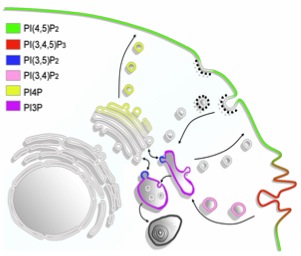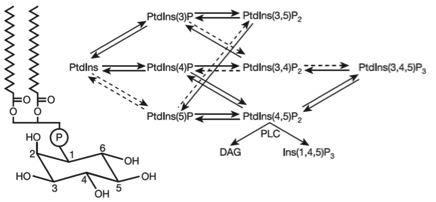Analysis of Phosphoinositides, Their Interactions, Metabolism and Transport
Assays Available for the Analysis of Phosphoinositides, Their Interactions, Metabolism and Transport
Phosphoinositides (PIPs), the phosphorylated metabolites of phosphatidylinositol, are membrane phospholipids that play critical roles in cell regulation. Their actions are mediated by protein interactions of their headgroups or by the signaling functions of their downstream metabolites. Their interconversions have an important impact on neuronal functions relevant to drugs of abuse, including signal transduction, synaptic transmission, and synaptic plasticity

Heterogeneous distribution of PIPs in intracellular membranes

Quantitation of Phosphoinositide levels:
- HPLC analysis of anionic lipid extracts from tissues and/or organs to detect cardiolipin, PS, PA, PIP and PIP2
- 3 H-inositol labeling of tissue cultures followed by anionic lipid extractions and HPLC analysis to detect PI, PI3P, PI4P, PI(3,4)P2, PI(3,5)P2, PI(4,5)P2, and PI(3,4,5)P3
PIP-protein Binding Assays
- Protein co-sedimentation, or floatation with liposomes of specific lipid formulations
Assays to Demonstrate Enzymatic Activity of PIP Metabolizing Enzymes
- Kinase assays utilizing 32P and specific PIP substrates and analysis by TLC or HPLC
- Phosphatase assays utilizing a Malachite Green Dye and specific PIP substrates